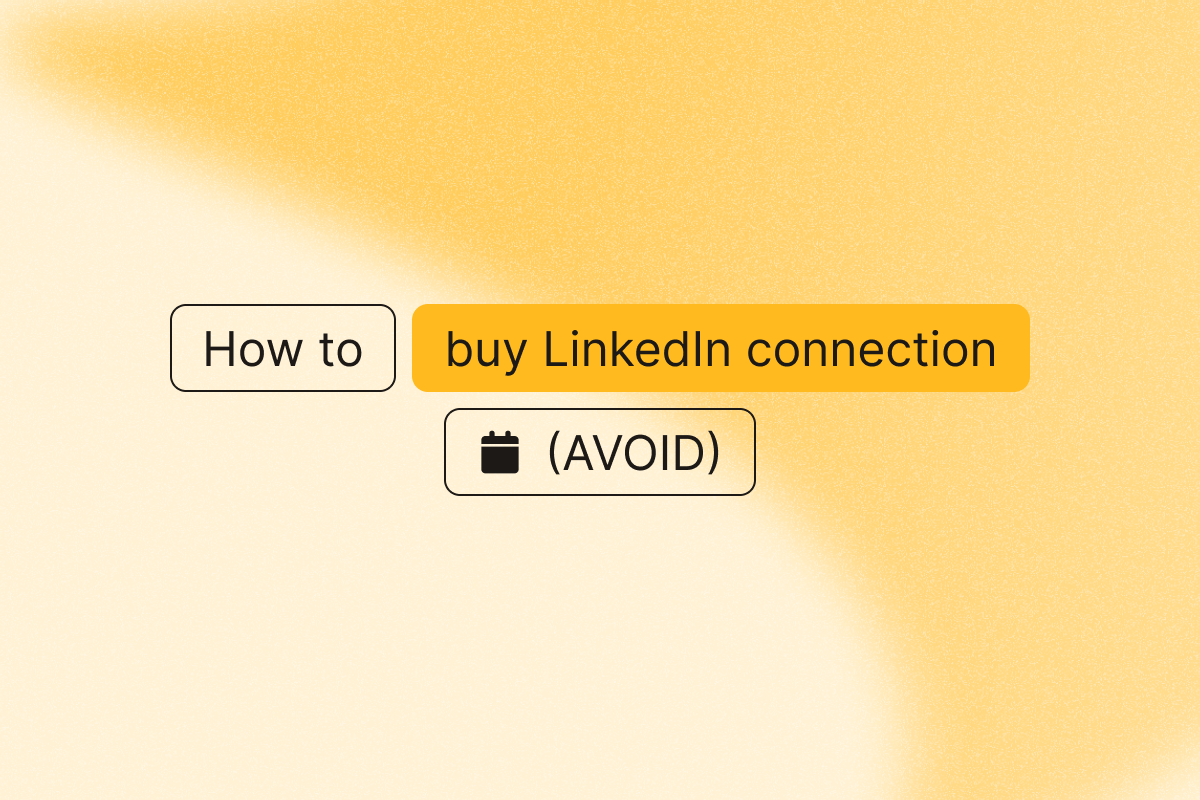⚠️ Warning: Buying LinkedIn connections breaks LinkedIn’s User Agreement and Professional Community Policies and risks suspending or permanently banning your account, not to mention damaging your reputation.
If you’re tempted to buy connections for quick social proof, pause. It’s risky, ineffective for real business growth, and easy to spot.
The good news? PhantomBuster can help you grow a valuable, engaged network the right way, while reducing risk when you follow LinkedIn’s guidelines and our safety controls. It’s lead generation as it should be.
We leverage PhantomBuster to strategically build and cultivate relationships with targeted personas for our B2B influencers. The platform enables us to precisely identify prospects by their LinkedIn job titles and roles, and then create personalized connection requests at scale. Our results speak volumes—acceptance rates that are 5-10x higher than other approaches. – Patrick Spencer, VP at Kiteworks“
What does buying LinkedIn connections mean?
Buying LinkedIn connections means paying third-party services to artificially inflate your connection count. These services often market their offers as a LinkedIn connections package or promise you’ll get high-quality connections, but the results rarely match the pitch.
Here’s what typically happens when you buy leads:
- You pay a service (usually $15–$800, depending on the quantity)
- They use fake or hijacked accounts to send you connection requests
- Your count jumps rapidly, often within 24 to 72 hours
- You appear more connected, but none of the relationships are real
Below is an example from one such LinkedIn connections service: 50 connections for $14.95. The profiles are fake but marketed as “realistic, high-quality looking accounts.”
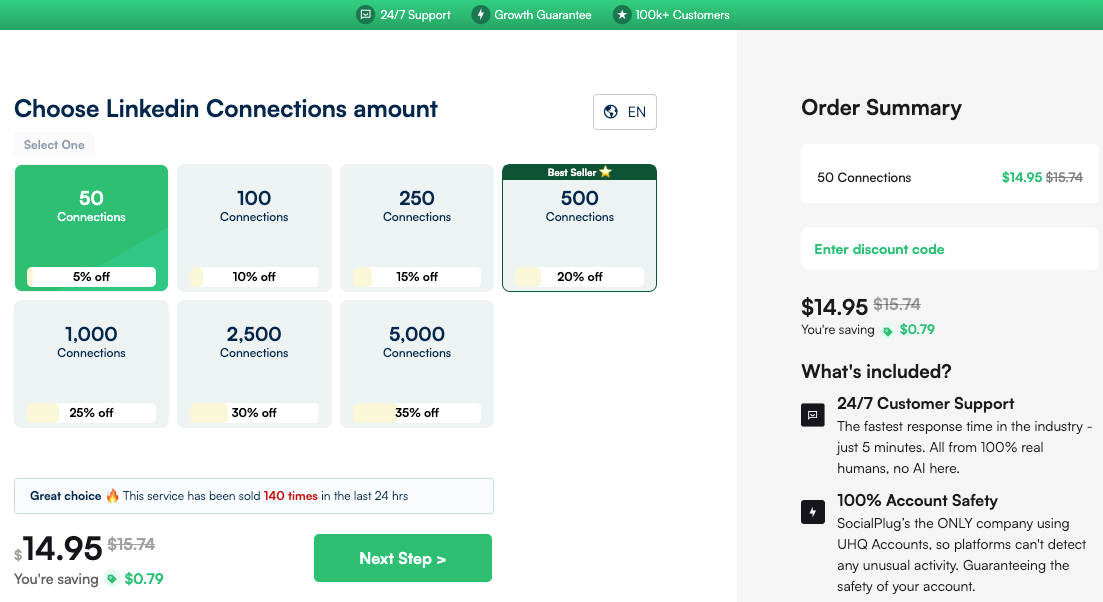
Buying connections is not the same as:
- Using LinkedIn’s official ads or premium subscriptions
- Following genuine networking strategies
- Running ethical automation with PhantomBuster’s pre-built LinkedIn automations to reach real prospects
The difference? Buying connections fakes credibility. PhantomBuster’s LinkedIn automations help you connect with real people who could turn into customers, partners, or collaborators.
Is it allowed to buy LinkedIn connections?
No, buying LinkedIn connections violates LinkedIn’s Professional Community Policies. It’s considered a form of artificial engagement that undermines the integrity of real networking.
What LinkedIn’s rules say:
- Using fake or purchased connections breaks the User Agreement
- Fake accounts and automated scripts are strictly banned
- Artificially inflating your network is flagged as deceptive behavior
- Violations can lead to account restrictions or permanent bans
How LinkedIn detects this:
- Monitoring for sudden connection spikes
- Analyzing patterns in connection sources and timing
- Investigating user reports and suspicious activity
- Cross-checking against known fake account networks
| Approach | LinkedIn’s position | Risk level | Business value |
|---|---|---|---|
| Buying connections | Prohibited | 🔴 Very high | ⚪️ None |
| Manual networking | Encouraged | 🟢 Low | 🟠 High |
| Ethical automation | Use conservatively at your own risk* | 🟡 Low-Medium | 🔴 Very high |
*Automation may violate LinkedIn’s terms. Users are responsible for following LinkedIn’s guidelines and using tools responsibly.
The bottom line: LinkedIn actively detects and penalizes connection buying. Responsible automation can grow your network without resorting to fake connections. Always follow LinkedIn’s rules.
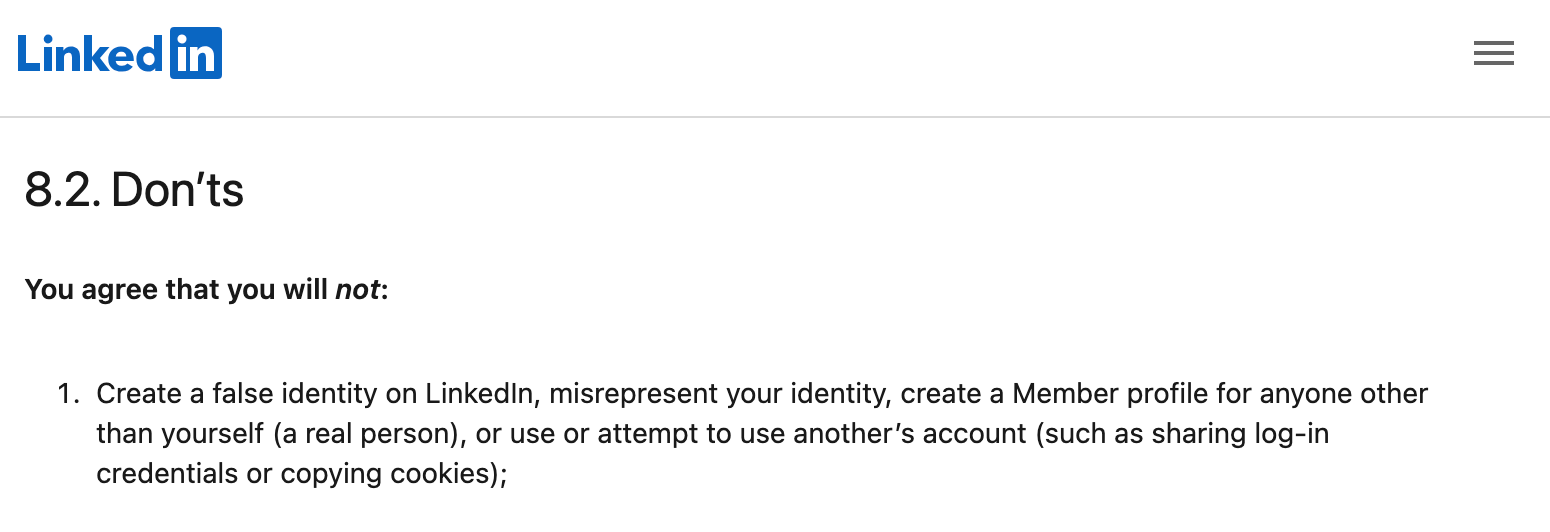
What are the advantages and risks of buying connections?
Buying LinkedIn connections might give the illusion of social proof, but it rarely delivers real value. Here’s what buyers hope to gain and why it backfires.
Earning quick social proof
Buying connections can create the appearance of popularity or professional status, at least at first. Here’s what buyers typically hope to achieve.
Perceived benefits:
- Network size: Large numbers can make you look more established.
- Visibility: A sudden spike in connections on LinkedIn may lead to more profile views.
- First impressions: A big network might signal influence to recruiters or prospects.
Reality check:
Savvy buyers look for engagement quality (comments, replies) more than raw connection counts. A profile with 5,000 connections and no interaction is a red flag, not a selling point.
PhantomBuster’s LinkedIn automations help you build genuine social proof by connecting with real prospects who engage with you.
Facing possible account suspension
LinkedIn flags sudden, unnatural growth and low-quality accounts. Sudden spikes, fake profiles, and low engagement increase your risk.
They can be triggered by:
- Sudden spikes in connection requests or acceptances
- Connections from incomplete or suspicious profiles
- Growth patterns that don’t match your usual activity
- High connection counts with zero engagement history
Here’s what might happen when LinkedIn detects that you’ve been purchasing LinkedIn followers or connections:
- First restriction: Temporary hold (three to seven days is common), but timelines vary.
- Repeat offenses: Extended suspension (weeks or longer).
- Severe cases: Permanent account ban with no appeal option.
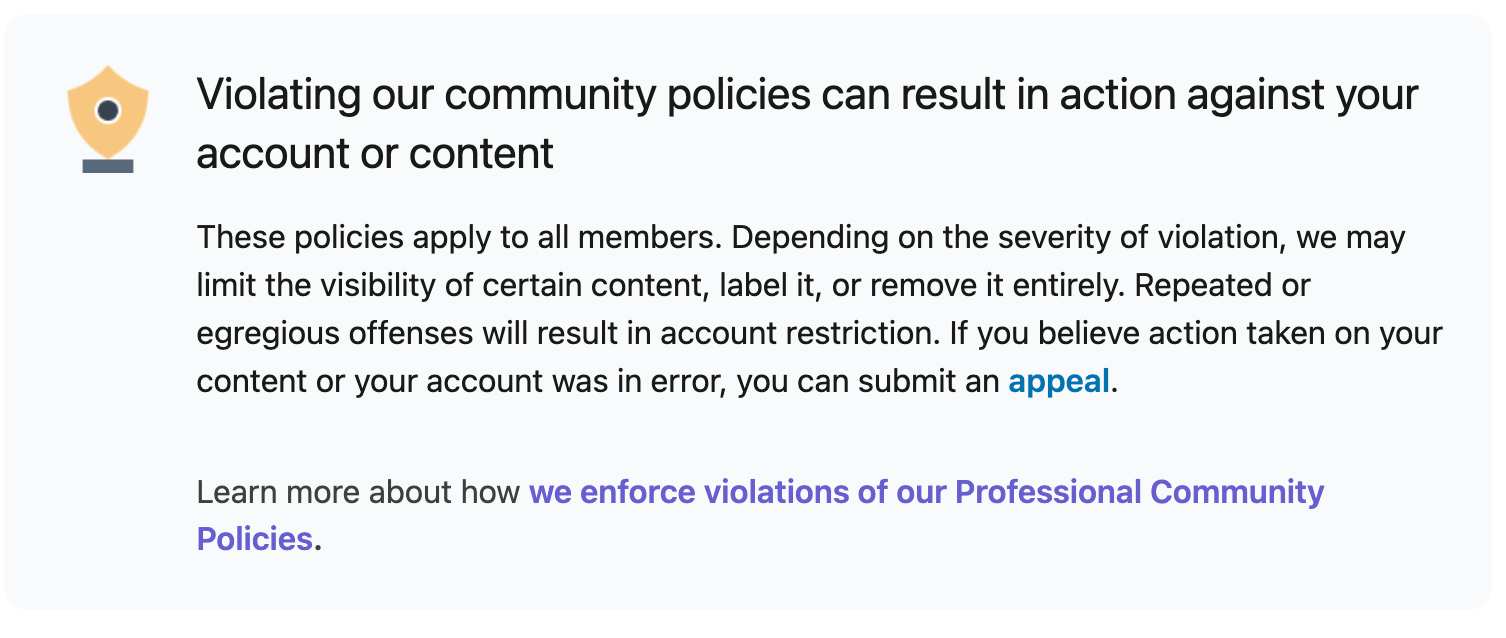 Recovery options are limited:
Recovery options are limited:
- Most restrictions require identity verification
- Multiple violations often lead to permanent bans
- Creating new LinkedIn accounts after bans is usually detected and blocked quickly
PhantomBuster’s LinkedIn Auto Connect spreads activity over time, follows conservative activity settings, and helps reduce risk when you stay within LinkedIn’s guidelines.
Uncertain return on investment
The cost of buying LinkedIn connections isn’t just financial. It comes with high risk and little to no business value.
What you pay vs. what you get:
- 100 connections: $5–15, zero business value
- 500 connections: $25–50, potential account risk
- 1,000 connections: $50–100, high suspension risk
Why purchased connections don’t drive business results:
- Their engagement rates are extremely low, often 0–2%
- They don’t reply to LinkedIn outreach or take sales calls
- They don’t lead to referrals, which means no sales pipeline value
- Many vanish when LinkedIn purges fake accounts
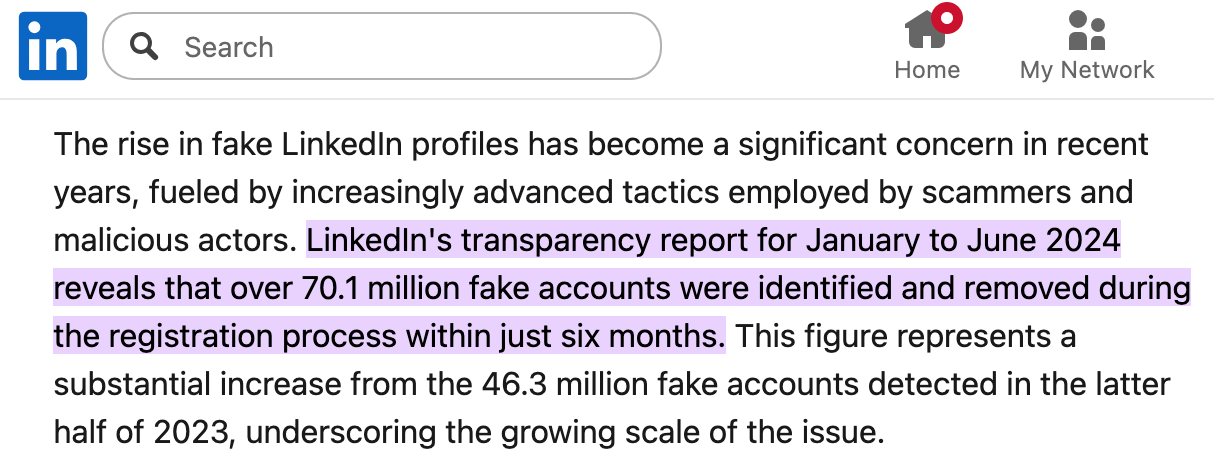
Compare to automation ROI:
Marketing automation helps businesses work more efficiently. Studies show pipeline growth of 45% and 25% increases in marketing ROI. When applied to LinkedIn prospecting specifically, you’ll see:
- Measurable increases in meeting bookings and sales opportunities
- Long-term relationship building with real prospects
- Qualified conversations that move deals forward
- Steady pipeline growth from targeted outreach
How buying connections works vs. how to automate growth
Understanding how connection-buying services operate shows why they’re risky. Then we’ll show you the better alternative: ethical automation that builds real relationships.
The purchasing process
Important: This violates LinkedIn’s User Agreement. Don’t do it.
Buying services often promise fast results, but they use fake or compromised accounts and put you at risk. Packages are cheap for a reason: they deliver fake accounts and risk.
Privacy concerns to consider:
Buying LinkedIn connections doesn’t just hurt your reputation. It can put your LinkedIn account security at risk. Here’s how:
- You’re exposing your LinkedIn profile URL and activity to unknown third parties
- Some providers ask for your LinkedIn login details, which is a huge red flag (never share these)
- Your account could become associated with fraudulent or blacklisted services, compromising your profile’s visibility and long-term account security
Recovering reputation takes time. Focus on authentic activity and steady engagement.
Smart prospecting steps
Ethical automation is a far better way to use LinkedIn for prospecting, without risking your account. Here’s how to build an integrated workflow that delivers real LinkedIn connections.
PhantomBuster helps you identify your ideal customer profile on LinkedIn, enrich key fields, and queue targeted connection requests, so you spend more time on conversations, not manual search.
Start by defining your target audience:
- Use PhantomBuster’s LinkedIn Search Export to find high-quality connections based on your ideal customer profile
- Filter by industry, job title, company size, location, or other key criteria
- Export targeted prospect lists of 100–500 LinkedIn users for focused, personalized outreach

Next, personalize your outreach:
- Use PhantomBuster’s LinkedIn Outreach automation to send personalized connection requests and follow-ups
- Write message templates that reference specific details from each profile (e.g., job title, LinkedIn groups, or shared interests)
- Start small and ramp gradually based on your acceptance rate and account health
We leverage PhantomBuster to strategically build and cultivate relationships with targeted personas for our B2B influencers. The platform enables us to precisely identify prospects by their LinkedIn job titles and roles, and then create personalized connection requests at scale. Our results speak volumes—acceptance rates that are 5-10x higher than other approaches. – Patrick Spencer, VP at Kiteworks“
Schedule your workflows:
- Run campaigns during business hours
- Space activities with conservative delays
- Monitor acceptance rates and adjust messaging based on performance
Pro tip: PhantomBuster’s LinkedIn automations help you stay within conservative activity ranges and scale outreach responsibly to get more LinkedIn connections.
Comparing short-term vs. long-term outcomes
Buying LinkedIn connections might look impressive at first. But over time, ethical automation delivers far more value to your professional network. Here’s an example of how results could unfold.
| Timeline | ❌ Bought connections | ✅ Automated prospecting |
|---|---|---|
| Week 1 | +1,000 connections, 0% engagement | +25 targeted connections, 40% acceptance rate |
| Month 1 | Same connections, potential warnings | +100 quality connections, five to 10 meaningful conversations |
| Month 3 | 20–30% connections disappeared | +300 targeted connections, 15–20 sales meetings booked* |
| Month 6 | Possible account suspension | +600 engaged connections, measurable sales pipeline growth |
*Example outcome: 15–20 meetings is achievable when acceptance and reply rates are strong.
Key differences:
- ❌ Bought connections: Quick numbers, low engagement, increasing risk to your LinkedIn account.
- ✅ Automated prospecting: Slow, steady growth with genuine engagement, lasting value, and lots of potential business partners.
What are the costs and where do people buy LinkedIn connections?
Understanding how the connection-buying market works shows why it’s such a bad trade-off compared to real LinkedIn growth strategies.
Low-cost vendors
Budget connection services typically offer the lowest prices but also the highest risks. These budget services promise fast delivery of “high-quality LinkedIn connections,” but what you actually get is far from it.
What you’re really paying for:
- Pricing: $3–15 per 100 connections
- Delivery: 24–48 hours, often using automated scripts or fake accounts
- Quality: Fake profiles with stock photos and missing details
- Lifespan: Many disappear within weeks as LinkedIn bans fake accounts
Common issues:
- Obvious fakes (no content, fake job titles, poor English)
- Irrelevant global connections that don’t match your ideal customer profile
- Suspicious activity spikes that risk LinkedIn account restrictions
- No customer support team when things go wrong
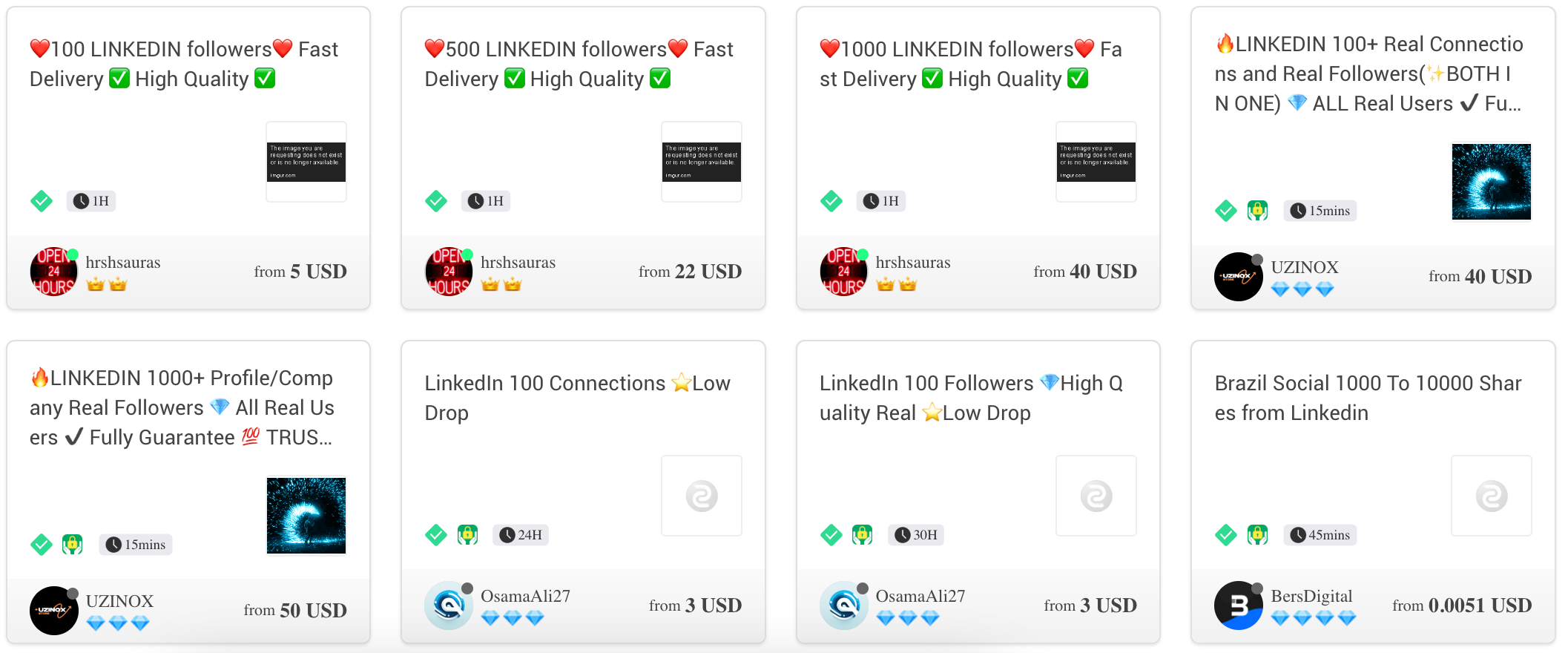
Premium vendors
Higher-priced services claim to offer “real” connections but still violate LinkedIn’s terms.
Premium service claims:
- Pricing: $50–150 for similar quantities
- Promise: “Real accounts” or “industry targeting”
- Delivery: Slower rollout over several days
- Support: Customer service and replacement guarantees
Reality check: Even “premium” bought connections offer minimal business value. The fundamental problem isn’t quality. It’s that you’re paying for relationships that don’t exist. No purchased connection will:
- Engage meaningfully with your content
- Respond to your sales outreach
- Provide referrals or business opportunities
- Help build your professional reputation
- Enhance your personal brand
Compare this to PhantomBuster’s LinkedIn automations, which connect you with real prospects likely to engage.
Hidden fees or upsells
Many connection-buying services use deceptive upsells that turn cheap packages into expensive scams. Watch for premium targeting fees, engagement packages to buy LinkedIn likes, replacement guarantees, and express delivery charges.
Red flags indicating scams:
- Requests for your LinkedIn login details
- Promises of “guaranteed results” or guaranteed engagement
- Prices that seem too good to be true
- No customer support team, refund policy, or service review page
- Payment only through untraceable methods like crypto or gift cards
⚠️ Important: Legitimate automation tools like PhantomBuster offer transparent pricing with no hidden fees and never request your login credentials.
How does buying connections affect your LinkedIn presence?
Buying LinkedIn connections doesn’t just inflate your numbers. It can damage your credibility and visibility across the platform.
How the algorithm reacts
LinkedIn’s algorithm rewards organic connections, consistent engagement, and steady activity. When your growth rate spikes unnaturally, or your network includes irrelevant or fake profiles, your content is deprioritized.
Instead of boosting your reach, purchased followers often cause:
- Lower content visibility in the feed
- Reduced appearance in search results
- A weaker LinkedIn profile in the eyes of real prospects
This is because the algorithm is constantly analyzing data such as:
- Connection quality
- Engagement patterns
- Account activity
- Growth history
Buying connections makes your profile look suspicious to the algorithm. That means fewer views, fewer conversations, and fewer networking opportunities.
Why quantity doesn’t beat quality
Big numbers might look good, but savvy LinkedIn users know how to spot the difference between real connections and artificial ones.
Recruiters and decision-makers look beyond your follower count. They check your LinkedIn activity, engagement quality, and mutual connections to judge if your network is real or just for show.
Here’s what really builds authority on LinkedIn:
- Quality LinkedIn connections who engage with your content
- Comments and conversations, not just likes
- Endorsements from authentic accounts or colleagues
- Regular posting of insights and relevant industry content
- Shared connections with trusted professionals
A profile with 500 engaged, relevant followers will typically outperform 5,000 purchased LinkedIn connections that never interact.
The engagement problem with purchased connections
LinkedIn ranks your profile and content based on engagement, such as likes, comments, reposts, and profile views. The more actively engaged your connections are, the more visible you become to a broader audience.
But purchased connections rarely engage. They don’t comment, reply to messages, or interact with your posts, which means your engagement rate drops as your network grows artificially.
Consider this comparison:
- Profile with organic growth: 800 connections, 50–80 engagements per post (6–10%)
- Profile with purchased connections: 2,500 connections, 15–25 engagements (1% or less)
Low engagement signals to the algorithm that your content isn’t valuable, reducing visibility even further.
In contrast, authentic LinkedIn followers and connections from an organically built network are more likely to have meaningful interactions. That’s what drives reach, credibility, and better LinkedIn performance over time.
Ethical alternatives: smart workflows and targeted outreach
Instead of buying fake connections, focus on building a systematic approach to genuine relationship building.
Personalized connection requests
The foundation of successful LinkedIn networking is sending connection requests that prospects actually want to accept.
What makes an effective connection request?
- Relevant reason: Explain why you want to connect.
- Common ground: Reference mutual connections, shared experiences, or industry interests.
- Value proposition: Hint at how the connection might be mutually beneficial.
- Professional tone: Keep it brief, respectful, and focused on professional value.
Message templates that improve acceptance and reply rates:
These templates work best when personalized with PhantomBuster’s exported fields.
Template 1, Industry peer: “Hi [Name], I noticed we’re both in [industry] and I’ve been following your insights on [specific topic]. Would love to connect and exchange perspectives on [relevant industry trend].”
Template 2, Event connection: “Hi [Name], I saw your presentation at [event] on [topic] and found your perspective really valuable. I’d love to connect and continue the conversation.”
Template 3, Mutual connection: “Hi [Name], [Mutual connection] spoke highly of your work at [company]. I’m working on similar challenges in [area] and would value connecting with you.”
Automation advantage: PhantomBuster’s LinkedIn Outreach automation can send these personalized messages at scale while respecting LinkedIn’s activity boundaries.
Responsible automation tools
The key to successful LinkedIn automation is choosing tools that work with LinkedIn’s systems rather than against them.
Responsible automation principles:
- Respect activity boundaries: Stay within LinkedIn’s daily and weekly limits for connection requests.
- Use human-like timing: Vary timing, add delays, and avoid obvious patterns.
- Choose safety-focused tools: Choose tools with built-in throttling, personalization, and account-safety features. Avoid anything that asks for your login or encourages mass messaging.
- Monitor performance: Track acceptance rates and adjust strategies accordingly.
PhantomBuster’s approach:
- Built-in safety limits that help reduce the risk of account restrictions
- Conservative pacing that spaces tasks naturally
- Browser-based automation that runs actions in context, but you must still follow LinkedIn’s rules
- Comprehensive analytics to optimize your outreach performance
Recommended automation workflow:
Sign up for a 14-day trial with PhantomBuster, and then test out this integrated connection workflow.
This workflow helps you identify your ideal prospects, enrich their data, connect with personalized requests, and follow up automatically. The result: qualified conversations and booked meetings, not just connection counts.
- Identify your ideal prospects: Use PhantomBuster’s LinkedIn Search Export to build a targeted lead list using LinkedIn filters (industry, role, company size, etc.).
- Enrich prospect data: Pull key personalization fields (job title, location, mutual groups) with PhantomBuster’s LinkedIn profile data export automation to tailor your outreach.
- Send personalized connection requests: Use PhantomBuster’s LinkedIn Outreach automation to send connection requests with conservative pacing. Start conservatively and increase gradually as acceptance stays strong.
- Follow up with new connections: Trigger follow-up messages in the same PhantomBuster workflow to nurture new connections using custom sequences that boost replies and drive conversations.
Pro tip: Use PhantomBuster’s throttling to pace safely. Start conservatively and increase gradually as acceptance stays strong.
Building real engagement
Growing your LinkedIn network is just the start. Real results come from genuine interaction, like sharing useful content, commenting thoughtfully, and sending messages that feel personal, not pushy.
Benchmarks to aim for: 30–40% acceptance and 10–20% replies depending on audience and message quality. When posts start getting comments (not just likes), and one in 10 leads agrees to a call, you’ll know your outreach is landing.
PhantomBuster can help you scale this. Track who engages with your content, follow up when someone changes jobs, and stay top-of-mind with light, well-timed check-ins. It’s a smarter way to turn new connections into actual business conversations.
How do you move forward with sustainable LinkedIn growth?
Building a valuable LinkedIn network takes time, but the right approach delivers lasting business results that far exceed any quick fix. If you want increased visibility and professional credibility, then this is the way to do it.
Your roadmap to sustainable growth (rather than buying LinkedIn connections or followers):
- Define your ideal prospect: Create detailed profiles of who you want to connect with and why.
- Set up PhantomBuster’s LinkedIn automations: Scale outreach with built-in safety controls.
- Focus on value creation: Share insights and engage meaningfully with your growing network.
- Track and optimize: Monitor your results and refine as you go.
- Build genuine relationships: Convert connections into business conversations and opportunities.
Responsible automation helps you build real business relationships, not empty numbers. It’s a far more efficient approach than anything promising cheap connections or more followers overnight.
Responsible automation helps protect your reputation, reduces risk, and compounds value over time, through engagement, conversations, and real opportunities.
Instead of chasing vanity metrics, you’re generating measurable ROI by connecting with people who actually matter. Because the sales professionals who win on LinkedIn aren’t the ones with the biggest networks. They’re the ones with the right connections, built on trust.
Automation just makes that process faster and more scalable. PhantomBuster helps you reach your ideal audience and reduce the risks of fake followers when you follow LinkedIn’s rules.
Start your free trial and see how ethical automation stacks up against shortcut services.
FAQs about buying LinkedIn connections
Does buying LinkedIn connections violate the platform’s terms of service?
Yes. It violates LinkedIn’s Professional Community Policies and can lead to account restrictions or permanent suspension.
How much does it typically cost to buy LinkedIn connections?
Prices can look cheap, which is exactly why quality and engagement are nonexistent, and the risk is high. If you want to buy LinkedIn connections cheap, then packages often cost $3–15 per 100, but none deliver real engagement or business results.
Can LinkedIn detect if I’ve purchased connections?
Yes. Sudden growth, low-quality profiles, and low engagement are common detection signals. When you buy LinkedIn followers, the platform flags these patterns quickly.
What happens to purchased LinkedIn connections over time?
Buying connections doesn’t work in the long run. Many vanish as LinkedIn deletes fake accounts. The rest rarely interact, leaving you with inflated connections on LinkedIn but no value.
How long does it take to build LinkedIn connections through automation?
With PhantomBuster, many users grow steadily each week when they target well and personalize. Results vary by audience and message quality. This lets you establish relationships and kickstart your LinkedIn journey authentically. Instead of chasing empty connections, you’ll be relying on authentic accounts that may engage, convert, or lead to new opportunities.
Get a 14-day trial of PhantomBuster to grow your LinkedIn network the right way. Remember, there’s no magic formula. But there are faster workflows to make it happen.
